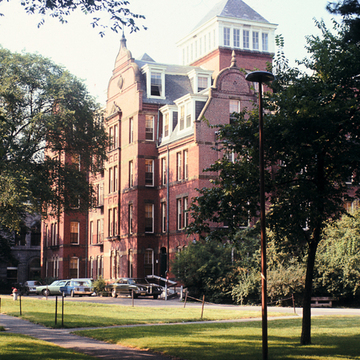Bridging Holworthy and University halls, Thayer Hall was one of three dormitories built by Charles W. Eliot following his election as president in 1869. Thayer (1869, Ryder and Harris), Weld (1870, Ware and Van Brunt), and Matthews (1871, Peabody and Stearns) halls represent Eliot's commitment to the concept of Harvard as a residential college during the first years of his tenure. Enrollment had risen dramatically, from fewer than 200 students during the early nineteenth century to 754 when Eliot took charge. Thayer, a massive brick structure with four-story wings flanking a five-story central pavilion, is the most restrained of the three buildings. Weld, a Jacobean design, and Matthews, which is Ruskinian Gothic, are picturesque masses with complex rooflines and oriel windows. Both Weld and Matthews reflect the strong desire on the part of Boston architects and their clients during this period to emulate English architectural trends.
You are here
President Eliot's Dormitories
If SAH Archipedia has been useful to you, please consider supporting it.
SAH Archipedia tells the story of the United States through its buildings, landscapes, and cities. This freely available resource empowers the public with authoritative knowledge that deepens their understanding and appreciation of the built environment. But the Society of Architectural Historians, which created SAH Archipedia with University of Virginia Press, needs your support to maintain the high-caliber research, writing, photography, cartography, editing, design, and programming that make SAH Archipedia a trusted online resource available to all who value the history of place, heritage tourism, and learning.


